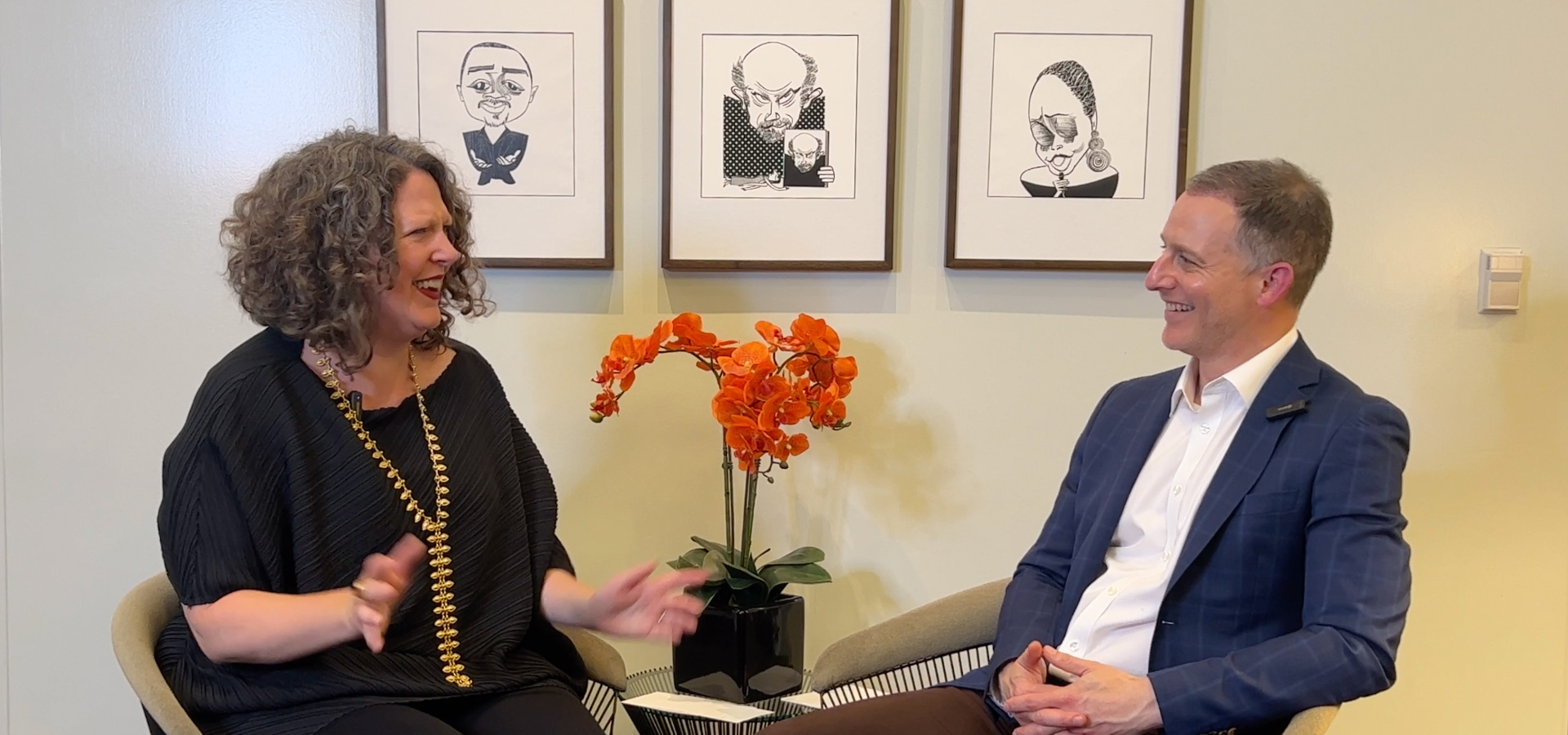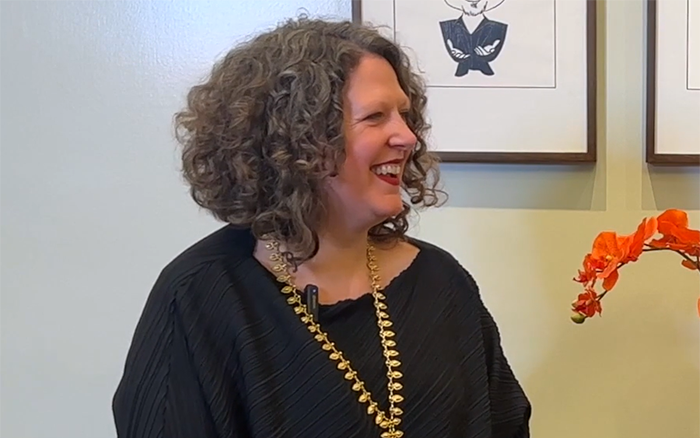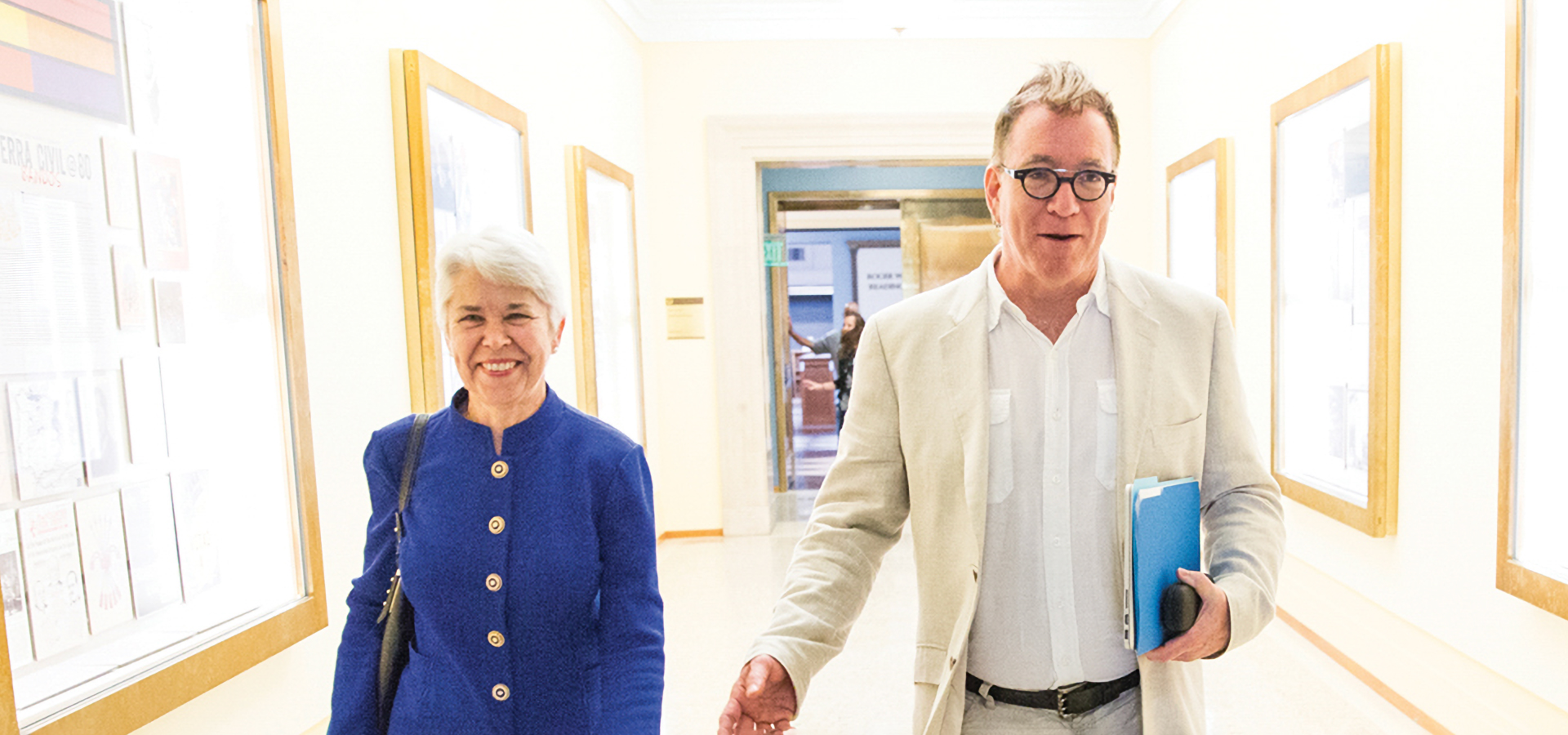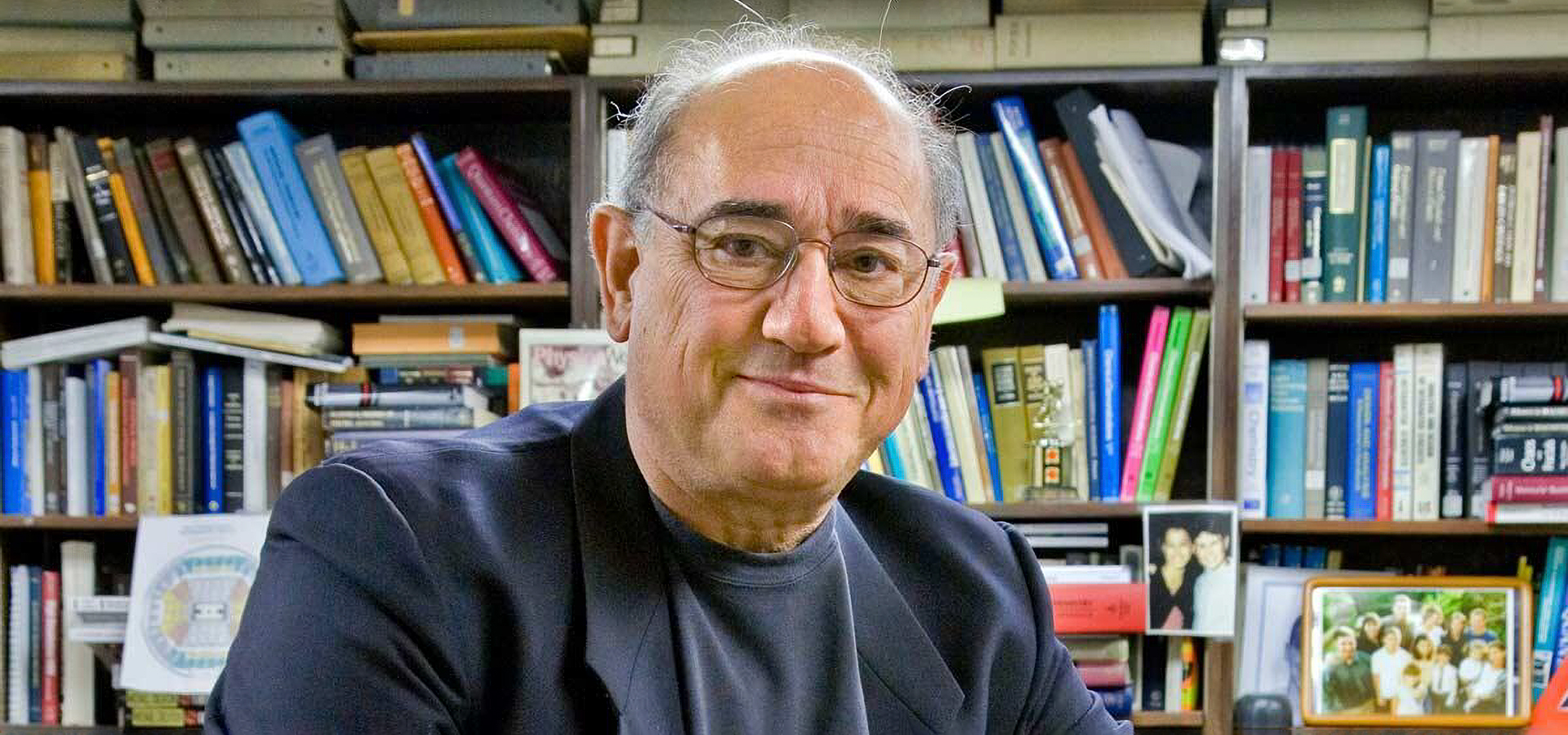

Cal Performances Artistic Leadership Reminisces on Memorable Moments from the 2022–23 Season
From the Two Who Saw It All!
Interview of Jeremy Geffen, Cal Performances’ Executive and Artistic Director, and Katy Tucker, Cal Performances’ Director of Artistic Planning. Video filming and editing by Tiffany Valvo, Cal Performances’ Social Media and Digital Content Specialist.
As we inch closer to the start of our 2023–24 season, Cal Performances’ Executive and Artistic Director, Jeremy Geffen, and Director of Artistic Planning, Katy Tucker, take one final moment to reflect on some of the highlights and surprises of the past year. In this video, they answer:
- What performance made you the most emotional? (0:33)
- Share a time when a member of a group or ensemble really stood out to you. (1:47)
- Which performance ran smoothly on the surface but, due to unforeseen circumstances, required lots of scrambling/problem-solving behind the scenes? (3:29)
- Share a moment (outside of William Kentridge’s campus residency) when you got to see an artist really connect with students. (5:13)
- In which performance did you feel the greatest sense of community? (7:21)
Note that, for context, you can find programs for each performance mentioned in the video linked in the transcript below.
Transcript
Jeremy Geffen:
Hi, I am Jeremy Geffen, Executive and Artistic Director of Cal Performances.
Katy Tucker:
And I’m Katy Tucker, Director of Artistic Planning at Cal Performances.
Jeremy Geffen:
We are seated backstage in Zellerbach Hall in the Green Room, which is generally where artists warm up, and it is the last thing they see before they see all of you when they walk out onto the Zellerbach Hall stage.
Katy Tucker:
And today, Jeremy and I are going to be looking back over the 22–23 season and sharing some of our favorite memories from this past year.
What performance made you the most emotional?
Katy Tucker:
I was just openly sobbing during William Kentridge’s week with us multiple times. But both parts of that performance [SIBYL], “The Moment Has Gone” by Kyle Shepherd and “Waiting for the Sibyl” were just transformative life experiences.
Jeremy Geffen:
I have to agree with you on this one, that like, from the from the moment that Kyle Shepherd started playing in “The Moment Has Gone,” there was something that just like instantly transported you.
But if I can add another one to this, just a few days earlier, we had the Vienna Philharmonic with us and gave a performance of Bruckner’s Symphony No. 8 that has to be on my top 10 lists of musical performances of my lifetime. It was one of those moments where you think, “I don’t know if the composer actually understood that this the piece was capable of this”—the depth, the feeling of ensemble, just the quality of the sound… That really got me, too.
Share a time when a member of a group or ensemble really stood out to you.
Katy Tucker:
After Camille Brown & Dancers’ first performance—they did two or three shows—after their first performance, I was walking out of the building, and I ran into one of the dancers who had in the piece done something like 10 or 15 successive jumps, just jump, like this, just straight up in the air like this. And he got so high and he was so pin straight, and it was so beautiful and athletic. And I said to him something like, “Bet you didn’t know you could do that in your dance career,” or something like that. And he’s like, and he said, “Yeah, this isn’t even my real job.” And I was like, “What else can you do better than this?” And he just laughed and walked away from me. Just like, what?
Jeremy Geffen:
So I’m thinking of the performance of Artemis. They were all stars, but I don’t think I was, and each one of them is a virtuoso. They’re also composers. So we had compositions from most of them. There was a new album coming out. The drummer, Allison Miller. I mean, she made Animal look like he was tamed, sedate. She was just the most energetic, inspiring, and kinetic performer. I could have watched her for hours.
Which performance ran smoothly on the surface but, due to unforeseen circumstances, required lots of scrambling/problem-solving behind the scenes?
Jeremy Geffen:
I have a feeling you’re probably thinking of the exact same situation that I am.
Katy Tucker:
The Guided Tour of the Exhibition?
A long story short: the cargo for some of the William Kentridge events didn’t arrive on time due to shipping issues in France! For reference, Guided Tour was on a Wednesday and the SIBYL premiere was Friday.
Jeremy Geffen:
Yes. So the morning of Guided Tour of the Exhibition, actually I think this plan had been made the day before.
Katy Tucker:
The day before, yeah.
Jeremy Geffen:
They sourced all of similar types of props and costume and even sets from within Zellerbach Hall and also from our friends at the Department of Theater, Dance, and Performance Studies.
Jeremy Geffen:
And on Thursday, I think, on Wednesday I think we got—
Katy Tucker:
Half of—
Jeremy Geffen:
Yeah. Some part of SIBYL, but none of Guided Tour.
Katy Tucker:
Correct.
Jeremy Geffen:
Thursday we got the remaining part, and they got that very complicated show up in a little over 24 hours. Which, I mean, I don’t think that was apparent to anyone in the audience.
Katy Tucker:
No. And a huge boon to our technical staff, who were really the people who were undergoing the most rehearsal process for that, because, of course the cast had just done it in Paris. Our crew had never moved the chair that breaks or swept up all of the papers that they throw all over the stage. And so they had basically 24 hours to learn an incredibly difficult show. And it looked fabulous on Friday night when it opened. So, a huge success. But a sweaty one!
Share a moment (outside of William Kentridge’s campus residency) when you got to see an artist really connect with students.
Katy Tucker:
This is something that I’ve known, I knew already, but it was really reinforced in a very real way. But Jeremy Denk is such an unbelievable performer, and an equally unbelievable teacher. He gave a masterclass this year for us in the music department. He worked with four young pianists out of the music department. And the depth of his knowledge about repertoire, the thoughtfulness with which he approaches music-making, and his ability to articulate it in such a human and totally open way, it was really touching, it was really beautiful. I loved watching him give that masterclass.
Jeremy Geffen:
Can I add one more? When Maxim Vengerov give his recital in October, you know, I didn’t realize—we are on the campus of a major university—there were so many students who clearly had grown up listening to his recordings. They found every entrance to this building and they waited outside each of them to meet him afterwards. And when we were driving out of the parking structure, we saw a group of people standing up at the corner. And this is like 10:30 at night on a Friday night in Berkeley; it’s not a time that you see these sorts of clusters of people. When it turned out they were waiting for him, he got out of the car, he spoke with every single one of them, as he did with all the other students he encountered. He was incredibly gracious and really engaging, and he loved talking to his fans.
In which performance did you feel the greatest sense of community?
Jeremy Geffen:
There are a lot of performances where you feel community, and it’s different types of community. Kyle Abraham’s piece for Ailey [Alvin Ailey American Dance Theater], Are You in Your Feelings?, is that—
Katy Tucker:
Yep.
Jeremy Geffen:
It was, like, the most virtuosic piece for that company featuring, you know, all sorts of combinations of dancers and so many different styles. And, you know, there’s this moment that you get when you’re all seeing something new for the first time, and that, “Oh my God, this is incredible”—that feeling was absolutely rising from the audience and you know, the electricity of the reception definitely reflected it.
Katy Tucker:
Parable of the Sower was—I’m not a sci-fi fan; I did listen to that book on tape in sort of preparation for our presentation of it… And to see all of the people come out because of Toshi, because of Octavia E. Butler, because of the combination of the two, you know, a very large portion of an audience that kind of comes already with some preconceived information; but then to be totally taken over and, like, beguiled by the absolutely gorgeous music in that opera, all kind of leading up to a group singing moment at the very end of a song that Toshi teaches everybody in the audience that her mother [Bernice Johnson Reagon] wrote… This is a very simple song about “a sower went out to sow her seeds.” And it just was such a beautiful cap to not only that piece, but our season, and it felt like there was a lot of involvement with each other in those moments. It was very heartening.
Jeremy Geffen:
I’m gonna add one more. Rachell Ellen Wong. One of the things that I know that we share is the belief in giving artists a shot at the beginning of their career. And, you know, when you’re introducing an artist to the public, all you’re doing is essentially giving them a turn at bat. And then it is up to them to hit the ball. And watching someone hit it out of the park… And by the way, it’s a miracle if that—
Katy Tucker:
Sports reference landed.
Jeremy Geffen:
—If that sports metaphor was correct, because I’m so bad with sports. But I just… the fire that came from her, like, there was an enormous amount of scholarship that went into that program because there were some really off-the-beaten-track pieces by composers that I think only a few people in the audience would’ve heard from. But, oh man, just that moment of discovery, it’s sort of similar to Kyle Abraham’s piece, that when you’re all having this moment together, you feel it.
Katy Tucker:
For sure, for sure.



